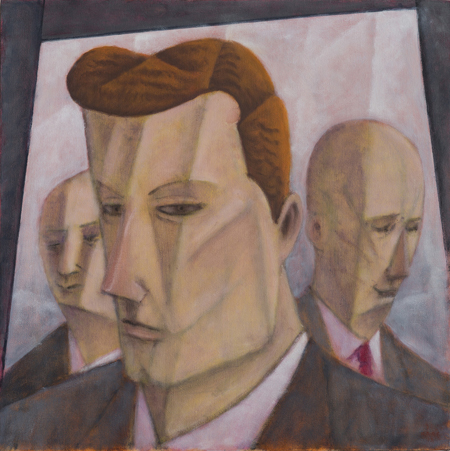
Continuing through July 27, 2013
Following in the vein of his erstwhile University of Washington professors Jacob Lawrence and Michael Spafford, 62-year-old David C. Kane has deviated from his mentors’ examples of multiple-figure-group compositions with social or psychological punch. His new work, two dozen oils on canvas and ink drawings, are all figurative, but the overwhelming majority are imaginary portraits. As in the imaginary word portraits of her artist friends Picasso and Matisse, Gertrude Stein is a good analogy for Kane’s new people. With their cubistically altered faces, no specific identities are perceivable; yet, as in Stein, an eerie psychic presence is felt. Words stand in for facial features in Stein; with Kane, solid planes of color coalesce into a grammar of interlocking shapes. Despite the often-missing eyes or mouths, as in "Duchess" and "MVP" (all paintings are 2013), many works project identity through period clothing touches. Kane proves that tiny wayward corners of early modernism can still be mined, if only for the quirky nostalgic tang they exude.
Six pairs of male and female heads generate a cumulative narrative of heterosexual couples in crisis and harmony. "Uncle Mom" and "Aunt Dad" suggest shifting gender roles. "Sis" and "Bud" use 1950s ponytails and crew-cuts to simulate sibling camaraderie. "Whistler" (a self-portrait) and "Bingo" share sky-blue backgrounds and Vorticist faces straight out of Wyndham Lewis. Satirical allusions to other modernists — Léger backgrounds; Rayonist sunbeams; Bonnard feathering — are supported by sumptuously tender brushwork.
Kane’s most technically accomplished body of work yet veers farther away from his earlier gloom and doom period. Following his widely applauded Frye Art Museum mid-career survey in 2007, Kane continued to mine the darker recesses of his earliest work. Espionage, film noir and science-fiction were all fruitful sources of inspiration. Now less driven by popular culture, less concerned about communicating dread and despair, Kane uses a wider palette and allows greater amounts of daylight. This comes closest to an optimism without, for once, an underlying and long-oppressive irony.
The two larger (24 x 24”) figure groups, "Magi" and "Seaside," are respectively ominous and celebratory. In the latter, a family of three on vacation with solemn expressions (and closed eyes) poses at the beach. In "Magi" Kane flirts again with the evil captains of industry as they loom through a doorway, smiling ever so slightly, as if to be grateful to not be in prison. With this older side of Kane peeping through, bad news is always just around the corner.
